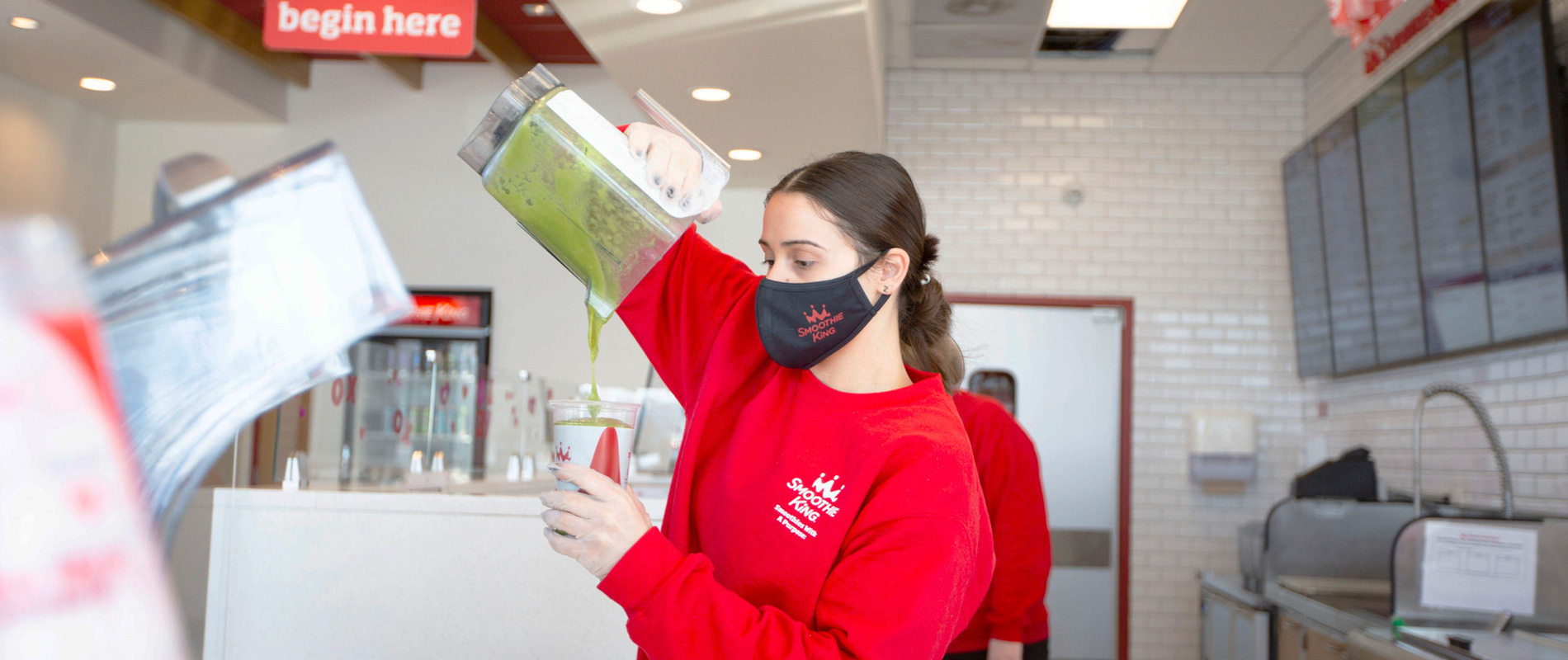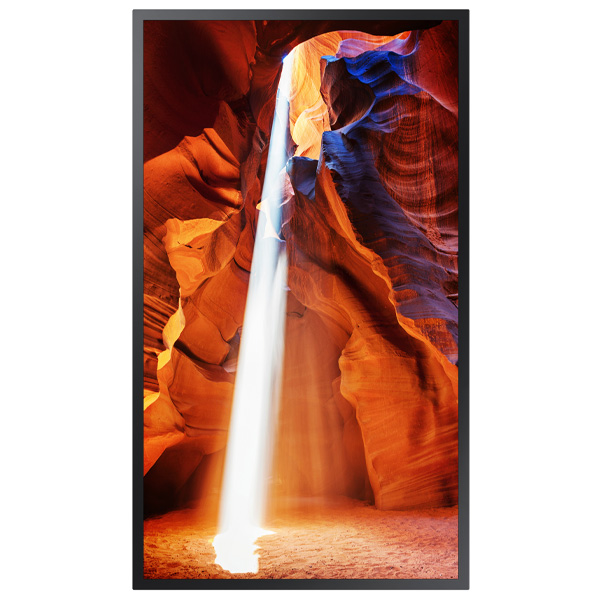
90% of sales are taking place in drive-thrus

Smoothie King is a privately held quick-service restaurant (QSR) chain with more than 1,300 locations worldwide. Founded in 1973 by Steve Kuhnau, the Dallas-based company works to help others achieve better health in a delicious way through smoothies.
The company is franchise-based with owner-operators in on three different continents. Through its Clean Blends promise, Smoothie King ensures the healthiest decisions are made when choosing ingredients, encouraging clean eating habits.
The Challenge
Identifying challenges of real-time messaging to customers
The health-centric, on-demand nature of smoothies presents an ongoing challenge to QSR operators who are focused on creating customized healthy drinks for their customers.
Local owner-operators of Smoothie King franchises have historically relied on printed menus in lightbox displays — inside and outside — to present ordering options to customers. But updating physical menus often takes weeks, as franchise operators must send menu revisions over to corporate so they can make the graphic design changes, and then the menus need to be printed and shipped by a third-party supplier.
Owner-operators like Yonas Hagos were looking for solutions to speed up menu and promotion changes, and to make these changes without any direct help from the franchisor.
An owner of several Smoothie King franchises in the Chicago area, northern Indiana and St. Louis, Hagos was also looking for an alternative to printed materials — both because of the disruption and because of unreliable weather. When printed menus need to be changed, employees usually have to make these updates outside of operating hours, even in the middle of winter.
Owner-operators wanted new tools that would influence consumers’ buying decisions and boost overall sales revenues while evolving their visual marketing tools.
They were also looking for better ways to manage and optimize menu presentations, particularly in the high-volume drive-thru, where their menu posters were limited to just three available enclosures.

The Solution
Collaborative technologies that make a lasting impression
Smoothie King franchisees are using Samsung display technology, managed by Washington-state-based digital signage solutions provider C3MS. The collaboration encompasses the development, delivery and management of a turnkey technology solution, including indoor digital menu display boards, an outdoor-ready multiscreen setup for drive-thru lanes and promotional displays in store windows.
The solution uses 49-inch narrow-bezel LCD displays behind the ordering counters in tiled ribbon arrays, delivering UHD 4K visuals, and uses a combination of upscaling, color optimization and anti-glare technologies to optimize menus as customers place their orders.
A set of three outdoor-rated, high-brightness displays are stationed at the ordering position of the drive-thru. The screens are weatherproof, self-cooling and filter-free, and they’re designed to be visible in even the brightest, sunniest operating conditions.
A separate “pre-sell” display is positioned earlier in the drive-thru lane to promote new products and special offers.
Samsung’s innovative, dual-sided, super-bright LCD OMN-D display is set up in a window, running promotions aimed at motorists and pedestrian traffic. On the other side of the window, a second screen faces the inside of the store, visible to customers as they weigh their ordering decisions.

All of the displays are commercial-grade, rated for uninterrupted 24/7 duty and include a three-year warranty.
C3MS’s management software solution allows for immediate changes to menu items, pricing or promotions. Hagos is among several franchisees who have contracted C3MS to handle these changes, including content. Effectively, the screen network’s day-to-day management is outsourced to C3MS, allowing Hagos and other operators to focus on serving customers and managing the product side of the business.
As C3MS CEO Ray Heiser points out, operators who rely on printed menus — at Smoothie King and at most other QSR operations — spend extra time and effort planning menu changes in advance, and then they have to wait for the updated menus to arrive in the mail.
Because the screens all share a network, operators can make changes remotely, usually in a matter of minutes. The restaurant display technology set is monitored from the C3MS operations desk, maximizing uptime for displays that have become mission-critical.
The move to digital isn’t just about looking good, either.
“The digital transformation is important because video and motion can connect with our guests so much easier than static boards,” said Kevin King, Chief Business Development Officer for Smoothie King. “They can also assist our team members in better explaining to the guest what makes a Smoothie King smoothie so nutritious, healthy and great tasting.”
Having increased autonomy over business changes is important to Hagos. “If I want to do certain things, or do certain specials, it’s just easy when you have digital.” Digital solutions also enhance operators’ ability to localize their promotions and menu items, as well as upsell high-margin add-ons.
Samsung’s outdoor displays are designed for the environmental demands of scenarios like drive-thru, and don’t require additional engineering by the companies developing enclosures and delivering installed solutions. The Samsung screens come ready to install in the display enclosures, and are largely plug-and-play.
“Samsung offers a solution that, from an integrator standpoint, allows those displays to be installed in a manner that no longer requires some of the more traditional high-bright hardware components, relevant to the enclosure for cooling, for any other environmental challenges,” says Heiser. “Those screens are meant to sit out in the elements.”
Heiser encourages clients to take advantage of Samsung’s after-care programs for “white glove” technical services and warranty. “Samsung offers an extremely fast turnaround, and an availability to reach their technical support group 24/7 to deal with any hardware-related issues,” explains Heiser. “They’re just great.”
The Technology
Dual-sided display
Samsung’s OMN-D Series dual-sided display with screens on both sides lets you maximize messaging while reducing equipment and installation costs. Built to handle 24/7 continuous operation and backed by a 3-year onsite warranty.
Digital menu board
Samsung’s QBR series for indoor and outdoor displays can showcase content in ultra-high definition through innovative upscaling technology and unique picture-enhancing features.
The Results
Making digital fundamental to store operations
Hagos runs seven Smoothie King stores, and he plans to add more. “Every store I’m doing is going digital,” he says. “So there will be a ton of stores.”
He’s among several Smoothie King franchisees who have converted over to digital menus. Heiser expects many more franchised locations, particularly new builds, will soon integrate digital solutions into their own operations.
“We are strong believers in consistency in our stores, so widespread adoption is a long-term goal,” said King. “We know that digital gives us so much capability to vary the menu and react quickly to shifts with the consumer, but there is an investment cost and ongoing costs we need to balance with the speed of change. We’re still early in our test but expect the boards to exceed our hurdle of a four-year payback.”
Drive-thru has become an essential component of QSR operations. Prior to the COVID-19 pandemic, says Hagos, motorists represented an average 70 percent of his sales volume. When health safety measures limited consumers’ in-store access, drive-thru sales soared to comprise over 90 percent of sales. Outdoor menu screens’ accuracy and timeliness is now even more essential to business success.
“Drive-thru and contactless service are huge right now, and something we think the guest will continue to expect after the pandemic,” King notes. “Our previous drive-thru board was particularly challenging because of the size of our menu. We are working on how to streamline to make it even more effective.”
With dozens of menu items to display in the drive-thru lane, franchisees are strategizing ways to trim back the menu selection for motorists, and how to use a pre-sell display for suggestive sales. By helping consumers make decisions — notably, promoting menu items that are quick to prepare — drive-thru operators speed up the line and increase throughput. It’s simple math: More vehicles per hour through the drive-thru means more sales, and higher revenues.
Hagos also highlights the aesthetics of bright digital screens and the ability to run changeable, full-motion messaging. “It’s more attractive to the consumer,” he says. “It looks cleaner, and we’re in the 21st century, you know; we’ve got to move with the times and not become a tired old brand.”
Going digital has brought only positive effects. “I have worked with Ray and his team at C3MS for seven years,” says King. “We use C3MS for music and now digital. We love working with him and his team. They make it simple and easy for us and our franchisees. Samsung has also been a great partner. We love the quality of their products and the innovation they bring to having full digital capability in our stores.”











